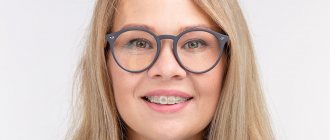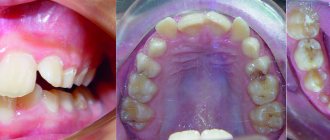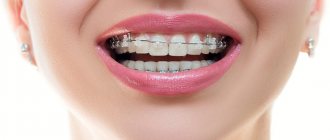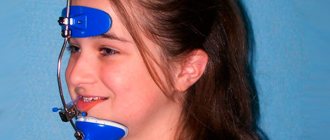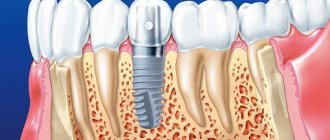No matter where you plan to get braces, it is very important to get your treatment plan from the doctor you are going to see. Without it, no one can guarantee you the result you expect, even if they promised it to you. In this case, a completely predictable orthodontic treatment turns into a dubious enterprise, controlled by the favorite Russian word “maybe”.
Can you get from point A to point B without a map, compass, road signs, or even using the stars to guide you? This is roughly how orthodontic treatment will go if it is not carefully planned before it begins. Such planning is carried out by an orthodontist based on data obtained during orthodontic diagnostics, and its final result is presented in the form of a presentation, demonstrated, explained in detail and agreed upon with the patient.
What does an orthodontic treatment plan include?
- Orthodontic treatment objectives
, which are formulated based on the analysis of the following parameters:
- Analysis of facial parameters
. The patient's face is examined from the front and in profile for symmetry and other parameters. It is very important to obtain a harmonious patient profile during treatment. Therefore, during such an examination, the possibility of removing teeth without compromising the patient’s appearance is studied. - Analysis of X-ray studies
: images and computed tomography. The doctor pays attention to the location of the teeth and roots, their inclination, rotation, relative position, missing and impacted (not erupted) teeth, the presence of tooth rudiments, etc., as well as the location of the jaws and their relationship. The location of the skull and jaw bones, the condition of the bone tissue and the temporomandibular joint (TMJ) are taken into account. The relationship between the upper and lower jaws and the contacts between them are especially important. Based on the patient data obtained during the research, special mathematical calculations are carried out by computer programs. Their results are recorded in a presentation and explained to the patient. - Analysis of the patient's smile
. What kind of smile is perceived as beautiful? An attractive smile has its own very clear standards. - The line of the upper teeth (smile arch) should be parallel to the lower lip.
- The smile should be wide. The more teeth are visible when you smile, the more attractive and open it is perceived by others.
- The middle line of the smile should coincide with the center of the face.
- In addition, the more visible a patient's upper teeth are when smiling, the younger he appears. And, conversely, showing the lower teeth when smiling adds years.
- Analysis of the patient's diagnostic model
. Using a plaster model of the patient’s jaws, the space deficit for each tooth and the proportionality of their sizes are calculated. You will find all the data and the doctor’s recommendations for changing them in this section of the treatment plan.
Therefore, the orthodontist must take into account all of the above parameters and plan the movement of teeth in such a way that, based on the available possibilities, the patient’s smile is as close to ideal as possible. After proper orthodontic treatment, the patient will look more attractive and youthful without any cosmetic surgery. The results of these calculations are also reflected in the treatment plan.
- Dental treatment objectives.
This part describes the entire necessary volume of therapeutic treatment (sanitation of the oral cavity), which, as a rule, is carried out in preparation before the start of orthodontic treatment. - Stages and timing of treatment
. This section outlines the stages of treatment and what will happen during each stage. As well as the approximate duration of the entire treatment and the time allocated for each stage. - Calculation of the cost of treatment under this plan.
The cost of ALL treatment according to this plan, as well as the size and timing of the required payments, is described in detail. - General information for the patient.
This includes examples of treating patients with similar cases, an explanation of orthodontic terms, and a handout for the orthodontic patient with general tips.
This includes treatment of teeth, gums, professional hygiene, enamel whitening before installing braces, prosthetics, and implantation.
Since periodontal diseases are a relative contraindication for orthodontic treatment, an analysis of the periodontal status with examination of the level of the gums and frenulum is mandatory.
In our clinic “Full Order” we work according to a special payment system developed for the convenience of our patients.
Such a payment system not only serves as an installment plan for orthodontic treatment, but also guarantees our patients that they will receive the desired result on time - after all, it is beneficial for us to treat our patients while adhering to all the planned time frames as accurately as possible.
This treatment plan is drawn up by the leading treating physician together with his team of orthodontists - so it is the result of the work of a consultation of doctors.
Video: How an orthodontist diagnoses
Procedure
Before starting treatment, mandatory preparation is required, which includes the following steps:
- visual examination of the oral cavity;
- Carrying out diagnostics, identifying contraindications, assessing pathology;
- analysis of information obtained as part of research;
- carrying out sanitation, treatment of diseases, including caries and inflammatory processes;
- office cleaning of hard and soft deposits of plaque.
Next, the bottom row is examined, selected as the basis. In most cases, it is not touched, but if the tilt is excessive forward or backward, the required corrective structure is selected and calculated. Then the upper dentition is assessed and the position of the individual elements is determined.
The next stages are:
- determining whether it is necessary to remove molars or whether it is possible to save all the teeth in the area;
- calculation of anchoring, protection factors against accidental movement of the device after installation;
- development of a treatment regimen, frequency of office visits to correct and monitor treatment, and timing of wearing the device;
- selection of a device for the retention period (mouth guards, lingual wire devices, retainers, crowns, activators and others are used).
Approval of the treatment plan with the patient.
A special appointment is scheduled for the patient, which takes 30 minutes. up to 1 hour, during which:
- The patient is shown a presentation and everything contained in it is explained in detail. We advise you to ask all the questions you have at this stage and not put them off until later. Then you may forget, consider it not important, but it is important that the patient understands his treatment plan, what is said “from and to”
- The treatment plan is discussed with the patient. The doctor, together with the patient, finally decides on the choice of the orthodontic device on which this treatment will take place.
- After making the necessary adjustments, taking into account the patient’s wishes, the treatment plan is approved and on its basis a contract for orthodontic treatment is signed.
Setting goals
Goals of orthodontic treatment:
- achieving the correct jaw ratio;
- elimination of dental distortions;
- restoration of chewing and speech functions;
- elimination of facial asymmetry and other defects.
Planning includes the following activities:
- initial examination and consultation;
- complex of diagnostic studies;
- development of a treatment protocol and agreement with the patient.
Most clinical cases allow for several correction options. The doctor conducts a consultation on each so that the patient can choose the most optimal option.
How to choose braces?
When choosing orthodontic equipment with which the orthodontist will treat the patient, you need to take into account:
Types of orthodontic appliances we work with:
- Bracket systems (non-removable orthodontic devices).
- Classic metal self-ligating braces DamonQ
- Ceramic transparent braces Damon Clear / sapphire Inspire Ice
- Invisible lingual braces Incognito and WIN
- Individual bracket system Insignia
Diagnostics
Repeated meeting with the orthodontist
An hour and a half is allocated for this meeting. This includes a more detailed study of the features of the jaw and a complete filling out of the medical record. The specialist is assisted in this by photography, scanning, making a model of the lower and upper jaw and x-rays.
Photo
The basis of high-quality dental treatment is the understanding that our body is integral and intervention affects many aspects at once. The position of the lower jaw affects posture, so the orthodontist will most likely take a full-length photo. In this way, the symmetry of the body and posture (the formed position of the body in space) is monitored. Close-up photographs of the face are also taken to evaluate the symmetry and aesthetics of facial features, the smile line, and the position of facial muscles and folds.
This way your orthodontic card will be replenished with the first photographs. In the future, photographs will be taken at intermediate stages and when the final result is achieved.
Casts
The traditional method of taking impressions is the use of impression mass. And although this method has become firmly established in use by orthodontists, it is quite unpleasant for the patient.
We have not abandoned the traditional method completely, but have introduced 3D scanning and projection of impressions in electronic form. The use of modern technologies speeds up preparation for the installation of a corrective structure and improves the quality of treatment. Moreover, we care not only about the quality, but also about the comfort of treatment. Therefore, we are always looking for those treatment and diagnostic methods that cause as little discomfort as possible.
After scanning the jaws, a 3D model of the jaw is made, from which the location of each tooth, the shape of the dentition, their relationship in closure (i.e., bite) is assessed and planned. where teeth will need to be moved during orthodontic treatment. In such calculations, the experience of a specialist plays a big role, and the doctors of the “Orthodontist Project” have more than 15-20 years of experience.
Below, you can watch a video that shows how impressions are taken in digital format:
Orthodontic card
The orthodontist carefully documents his observations, diagnostic results and data from scans and photographs of the jaws.
X-ray diagnostics
This 30-minute study includes:
- CT scan of the jaws. This picture shows all the teeth at once, even impacted ones (those that have not erupted). You can evaluate their position and make a projection of movement during bite correction.
- CT scan of teeth. Computed tomography has a three-dimensional image and allows you to see how the roots are located and what the volume of bone tissue is. Our specialist helps our specialist in deciphering and processing tomogram data using Diagnocat artificial intelligence. In the future, each of the consulting dentists uses this transcript for the final conclusion. Such a comprehensive diagnosis of modern artificial intelligence and an experienced professional increases the accuracy and quality of the examination. There is a separate article on our website describing such research in more detail.
- TRG (teleradiogram) of the head. Lateral and direct projections display the bone structure and soft tissues. TRG allows you to accurately determine the size of the jaw, the angle of inclination of the dentition, etc. The teleroentgenogram is the geometric basis of diagnosis and treatment. To decipher it, knowledge of anatomy, mathematical formulas and experience in making such calculations is required. Therefore, if an orthodontist prescribes a TRG image for you at the beginning of treatment, you can be confident in his competence and professionalism! “Orthodontist Project” specialists have sufficient experience in using such technologies and guarantee high-quality treatment. You can read more about TRG in the article on our website.
Bite correction process
The treatment of malocclusion itself is the constant wearing of installed braces. The patient is scheduled for monthly visits to the doctor, during which the orthodontist looks at the progress and decides to replace the arch with another one. Arcs differ in their final shape and require consistent use. Each subsequent arch brings the bite closer and closer to the ideal state calculated at the first stage.
The patient can contact the orthodontist earlier if one of the braces has become “unstuck” or if he feels excessive discomfort. This main stage lasts from 10-12 months to two years. In some cases, even longer. When wearing braces for the first time (as well as when replacing the arch with the next one), unpleasant sensations may be observed. It's unavoidable.
Remember that when wearing braces, it is very important to pay due attention to oral hygiene and the braces system itself. Dental health depends on this. Physically, getting used to the presence of braces in the mouth occurs after 2-3 weeks. Psychologically, this takes about 3 months or even more.
Inspection and consultation
First of all, when you visit a doctor with a desire to correct your bite, an initial examination of the current condition of your teeth and gums is carried out. By the way, the therapist himself may recommend that you see an orthodontist and undergo a consultation if he notices any pathology in the development of teeth. The fact is that a correct bite affects not only the visual, aesthetic component, but also directly relates to the health of teeth and gums. A correct bite ensures proper nutrition of the teeth with the necessary microelements, oxygen and ensures the safety of the teeth, preventing their early destruction.
At the first stage, a complete x-ray of the teeth is taken, on which the main parameters are measured and a complete treatment plan is drawn up. The doctor offers you suitable braces and helps you choose the type of braces and their appearance. During the consultation, you will immediately find out the full cost of all stages of treatment, including the braces system itself, auxiliary materials and visits to the doctor.
When the treatment plan is drawn up and the type of braces is selected, their installation begins.
Retention period
After all the teeth have been moved (and only the orthodontist decides when the treatment is completed), the braces are removed. The arches are removed, the locks are removed from the teeth, and professional dental hygiene is performed. Now it is important to keep the bite in this state for some time until the gums and teeth themselves “retain” this arrangement as natural. Retention mouth guards are used for this purpose.
These mouth guards are made individually based on a computer model of the new bite. You should wear these aligners yourself for some long time (several months, a year, only an orthodontist can call it more precisely). After the retention period, the entire complex of bite correction is completed and you enjoy your perfect and healthy smile!

